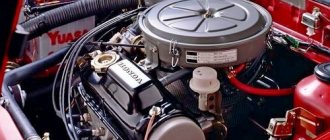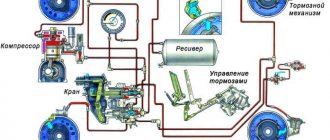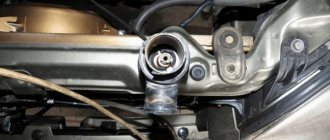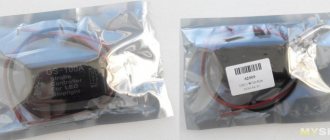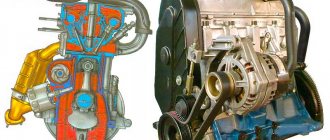Having bought a used gas car, I was happy that I would save on fuel. In fact, I ran into a bunch of problems with gas equipment, which I managed to solve after a year of digging on the Internet, reading forums and visiting various gas service stations. The recommendations presented are based on my personal experience as a self-taught person, and are addressed to beginners and beginners who want to understand and configure their machine themselves.
Geely CK2 car. Equipment: — Gearbox Tomasetto Alaska AT-09; — REG FAST Light injectors (blue); — ECU (electronic control unit) Stag 4 plus.
Step one - look under the hood of the car.
Purpose: 1) Gas valve: - the valve is installed in the engine compartment between the cylinder and the reducer - the valve is closed or opened by the gas line at the command of the switch / switch / control unit - when the power supply is turned off, it must be in the closed position
2) Reducer: - evaporation of a liquid propane-butane mixture (petroleum gas) is carried out by reducing pressure and heat exchange between parts of the reducer heated by the cooling system fluid - automatic reduction of pressure to the operating level
3) Gas injectors (injectors): - a block of gas injectors is installed in close proximity to the intake manifold and is connected by hoses to injectors embedded in the manifold as close as possible to the intake valve - the main parameter of the injectors is the minimum opening time. The shorter the opening time, the faster the injector works and the gas supply can be more accurately delivered.
4) MAP sensor (gas pressure and temperature sensor): a sensor that measures the gas temperature directly in the gas flow. It is combined with a gas pressure sensor, which allows the gas ECU to make the correct calculations and corrections
5) Fine gas vapor phase filter: - installed between the reducer and gas injectors - provides fine filtration of evaporated gas (70-80 microns)
What to pay attention to:
1. The coolant hoses going to the gearbox must be thick and cut parallel to the stove. If you have a piece of thick hose on the gearbox fitting, and a pinky finger-thick hose is inserted into it, there will be problems with warming up the gearbox, see the article.
2. Don’t be lazy, tighten all the clamps. Over time, the hoses become compressed and the gas begins to leak.
3. Check the wires going from the HBO brain to the battery. They're flimsy. There are many cases described on the Internet where problems with HBO were associated with fallen contacts.
4. The recommended position of the nozzles is vertical. He achieves this by attracting them with plastic clamps to “whatever is more convenient.” When carrying out maintenance, the technicians cut off these clamps, and then are often too lazy to restore everything as it should be, and the injectors hang “as is” on their hoses.
Step two - purchase a cable and install the software.
There are two options with the cable: we either buy it or make it ourselves - the Internet can help. I bought. We download the software from the official website (www.ac.com.pl), it is free (more precisely, it is included in the price of your gas ECU). For mobility, we install the software on a laptop. There are a couple of points here: - the laptop battery must withstand at least 10-15 minutes of operation, otherwise you risk turning it off in the middle of calibration; — Internet access is desirable: a) to update the firmware of the gas ECU; b) if you have Windows 7. The fact is that the sneaky Windows 7 installs drivers only on the USB port where you plugged the cable. If it suddenly becomes loose and you decide to plug the cable into another USB, then Windows 7 will start downloading new drivers from the Internet and installing them again for this particular USB port. We connect the cable to the connector of the gas ECU and the laptop. Let's launch the software.
Step three - setting up the HBO.
Before getting into the settings, I recommend reading the article; the author sensibly outlined the principles of operation of a gas ECU.
Below is the text taken from here. Comments have been added (K:) on the selection of some parameters, based on our own experience.
After installing the program, connect the interface cable to the control unit, start the car and launch the program. In the window that opens, we will see different tabs, settings, etc.
Question No. 1. What equipment is best to install on a car? Propane or methane?
Answer: For owners of passenger cars, it is more advisable to install propane gas equipment (liquefied petroleum gas or LPG) on the car. Re-equipping a car when installing propane gas equipment is less expensive than when installing methane gas, and accordingly, the installed equipment will pay for itself faster and begin to bring net savings. The price for installing gas equipment on a car in our service starts from 12 thousand rubles (for budget carburetor cars) and ends at over 30 thousand rubles (4th generation gas equipment for 8-cylinder foreign cars). The advantage of propane equipment is the presence of a larger number of refills and sufficient cylinder capacity.
Repair of pressure, vacuum and gas temperature sensor
Most motorists, if the pressure sensor malfunctions, immediately change it, and this is not strange, since the installers themselves claim that the sensors are not repairable. However, in practice everything is a little different. There are ways to resuscitate these sensors, after which they work successfully for quite a long time. The cost of a gas pressure sensor is about 2-3 thousand rubles, so the question, as you understand, is relevant and worth understanding.
For repairs we will need:
- Soldering iron and skills to work with it;
- New sensor, see photo (you can buy a pressure or vacuum sensor on the Internet on Ali or another site that specializes in chips);
- Thermal paste KPT-8 (preferably);
- TORX T10 screwdriver (asterisk).
Actually, repair
- We dismantle the sensor, clean and purge it.
- Using something sharp, carefully pry off the plastic cover, under which there is a board with sensors. It is advisable not to break anything.
- We unscrew the board, it is secured with TORX “T10” bolts and take it out of the case.
- We unsolder the faulty sensor we need, remembering its location.
- We take the new sensor and carefully solder it into place, also do not forget to put on the O-ring.
- Just in case, we check the inlets of the pressure and vacuum sensor.
- If there is thermal paste, I would recommend replacing it on the temperature sensor.
Further assembly is carried out in reverse order. At this point, the repair of the gas pressure sensor is completed; all that remains is to install it in place and check the operation of the gas equipment. Thank you for your attention, I hope it helped!? Leave your comments and thoughts on this matter in the comments. Goodbye everyone and see you again at the HBO shop.
Source
HBO installation diagram
Liquefied petroleum gas (propane-butane) under pressure flows from the cylinder (1) into the high-pressure gas line (3). Gas flow from the cylinder occurs through a multivalve (2), through which refueling is also carried out using a remote refueling device (4). Along the line, gas in the liquid phase enters the gas filter valve (5), which cleans the gas from suspended matter and tarry deposits and shuts off the gas supply when the ignition is turned off or when switching to gasoline. Next, the purified gas enters the evaporator reducer (6) through the pipeline, where the gas pressure is reduced from sixteen atmospheres to one. As the gas intensively evaporates, it cools the gearbox, so the latter is connected to the engine’s water cooling system. The circulation of antifreeze allows you to avoid freezing of the gearbox and its membranes. Under the influence of the vacuum created in the intake manifold of a running engine, gas from the gearbox through the low-pressure hose through the dispenser (7) enters the mixer (8), installed between the air filter and the carburetor throttle valves. Sometimes, instead of installing a mixer, gas fittings are directly inserted into the carburetor. Operating modes (gas or gasoline) are controlled using the fuel type switch (10) installed on the instrument panel. When selecting the “GAS” position, the switch opens the gas solenoid valve (5) and turns off the gasoline solenoid valve (9). And, conversely, when switching from gas to gasoline, the switch closes the gas valve and opens the gasoline valve. Using LEDs, the switch allows you to control which fuel is currently being used. The switch can be equipped with a fuel level indicator in the cylinder (for this, the multivalve must be equipped with a fuel level sensor). The installation of third-generation gas equipment on fuel-injected cars differs in that instead of a gas valve, an injector emulator is used to cut off the gasoline supply. When gas is supplied, this emulator simulates the operation of gasoline injectors so that the standard computer does not go into emergency mode. For the same reason, you need to install a lambda probe emulator. Fourth generation gas equipment systems are distinguished by the fact that gas is supplied directly to the intake manifold through special gas injectors. They are controlled by their own electronic control unit, which synchronizes its operation with the standard controller and simultaneously performs the functions of an emulator.Main components of gas equipment
The evaporator reducer is used to heat the propane-butane mixture, evaporate it and reduce the pressure to a value close to atmospheric pressure.
The gas reducer is designed for small cars with an engine capacity of up to 1.6 liters. Due to its compactness, it easily fits in the engine compartment of a car. May have vacuum or electronic control.
The solenoid gas valve is used to shut off the gas line when the engine is parked or running on gasoline. Equipped with a filter for cleaning the fuel mixture.
The electromagnetic gasoline valve in carburetor cars cuts off the supply of gasoline when the engine is running on gas. In injection cars, its functions are performed by an injector emulator.
Fuel switch - installed inside the car. There are switches on which the gas level in the cylinder is shown using LEDs.
The multivalve is mounted on the neck of the cylinder. Includes filling and flow valves, gas level indicator and sampling tube. A special high-speed valve stops gas leaks in case of emergency damage to the gas main.
The ventilation box is attached to the neck of the cylinder. A multivalve is placed inside it. In the event of a gas leak from the cylinder, the ventilation box removes its vapor from the luggage compartment to the outside.
The remote filling device is used to safely connect the filling hose when filling a gas cylinder. Usually crashes into the rear bumper.
Capacity for liquefied petroleum gas. There are cylindrical and toroidal cylinders (for a niche for a spare tire). According to safety regulations, fill no more than 80% of the full volume.
Rough adjustment for load. Peculiarities
When this option is selected, it is customary to change the cells; this is done not by revolutions, but solely by injection time. All that is required is to remember the fuel injection time, this is done at certain points in the movement, after which you need to switch to gas. This is how the 4th generation gas equipment is configured, the nozzles are adjusted and the work in general occurs. In addition, the 4th generation HBO, namely the pressure adjustment of the reducer, plays an equally important role.
It is important to know! As for the working pressure after the auto-calibration procedure, it will be automatically set, and at the level at which the adjustment is carried out. Regarding the minimum pressure, this is the gas pressure below which the system will automatically switch the vehicle to gasoline.
Attention: Every driver must understand that adjustment of the LPG gearbox, as a rule, is required only at the time of installation of the unit. But after one hundred thousand kilometers, it is necessary to perform diagnostics. It is also possible to service 4th generation gas equipment with your own hands, but only if you have the appropriate experience, knowledge, and equipment that allows you to do this.
If you consult with specialists, you can find out how to remove 4th generation HBO with your own hands, doing it at home. You always need to know that the proper operation of the unit does not depend on the quality of the electronic settings, as for some reason most car owners believe. Indeed, after a certain period of operation, valves and membranes begin to wear out, resulting in excessive gas consumption.
But this unpleasant moment can be delayed if you learn about the intricacies of proper operation of the equipment. For example, as for starting the engine, this should always happen exclusively on the car’s native fuel, which is often forgotten. Only at the moment when the engine temperature reaches thirty degrees can you switch to gas.
This is explained by the fact that the gearbox membrane freezes in practice at low temperatures. Therefore, the gearbox must be connected to the antifreeze lines, and only this way. If you want to configure the 4th generation LPG gearbox yourself, you need to realize in advance that this is not as easy to do as it seems.
Before doing such work, do not forget to warm up the engine, after which you can turn off the gasoline supply. If there is a need to adjust the sensitivity of the gearbox, then you need to unscrew the sensitivity regulator, and the procedure is performed at the moment until the idle speed values change.
Next you need to tighten the regulator and check the setting. All you need to do is press the accelerator pedal - the engine should not react to such an action, and accordingly, you should notice the absence of delays and jerks. Of course, if you managed to configure the 4th generation LPG yourself, and you did everything correctly, then the internal combustion engine will work stably and accurately.
Pressure sensor: location, features
The gas pressure sensor is located on the multivalve, which is attached to the inlet of the gas cylinder. So, the sensor monitors the gas pressure in the cylinder (in other words, the amount of gas), if it is too low, it sends information to the LPG control unit, and it is advisable to switch the car to gasoline. If the switch to gasoline occurs spontaneously, it means that the pressure sensor has failed. Pressure sensors, as one of the mandatory components of a car’s gas cylinder equipment, are produced by all leading specialized gas equipment companies: Alpha, Lovato, BRC, Digitronic, etc. During refueling at a gas filling station, the pressure sensor will prevent the cylinder from overfilling. There is a gas pressure indicator on the display inside the car. If the gas in the cylinder runs out (i.e. the pressure drops), the driver cannot help but notice it. The indicator will either flash or beep.
Possible malfunctions and checks
Any, even the most advanced equipment can fail. Its elements, such as sensors, are durable devices and break very rarely.
Reasons for gas sensor failure
The signal from the gas electronic control unit that controls the injectors is adjusted by three factors: pressure in the injector rail, gas temperature, antifreeze in the cooling unit, on which the operation of the gearbox depends. When a breakdown occurs at one of these components, the coordinated operation of the gas equipment is disrupted with all the ensuing consequences.
Possible reasons why the temperature sensor does not work may be the following:
- There is voltage on the device, but it sends a signal to the ECU, which means there is no contact between these two devices. The cause is identified by diagnosing the connecting cables.
- There is no voltage on the device. This means that either there is no power supply to it, or it is out of order. The unavailability of power is checked by “ringing” not only the temperature sensor itself, but also the pressure sensor and electronic cables.
- If the device is burnt out or there are other reasons why it does not provide temperature values, it is impossible to configure it. They carry out diagnostics of all elements of the HBO system that are somehow connected with it.
To restore functionality, the cause of the malfunction is eliminated. In case of problems in the electrical line, the breaks are eliminated. When the device itself fails, it is replaced.
Frequent errors that the temperature sensor sends to the electronic control unit are very rarely associated with its breakdown. More often than not, the reason is incorrect configuration. It is necessary to use a connecting cable, a computer and the appropriate software to perform diagnostics and adjustments. It is necessary to take into account the modification of the gas equipment and the technical features of the car model where it is installed. This cannot be done without special knowledge.
How to determine a faulty gearbox temperature sensor?
You can determine when the gas reducer temperature sensor has failed by the following signs that are difficult to miss:
- The internal combustion engine does not switch to a gas mixture.
- The evaporator has not warmed up to the optimal temperature, and the engine has already switched to a gas mixture.
How to check the temperature sensor on the LPG reducer? You need to unscrew it from the gearbox and measure the resistance. At room temperature it should squeeze out 1.6 kOhm, when heated it will begin to drop. If, when the sensor heats up to approximately 60℃, the resistance drops to 0.5 kOhm and again sharply goes to infinity, then there is an open circuit. This state of affairs cannot be ignored. The engine will not switch to gas. This leads to breakdowns of the MAP sensor, injectors, gearbox, and even the motor.
If you resort to a trick and program the ECU for the “warm start” function, the car will start immediately on gas. With this layout, the injectors and gearbox wear out faster, and in the cold in winter, the car’s engine will not start at all.
Currently, there are several models of gas controllers on sale that do not require connecting a reducer temperature sensor. In order for these systems to switch from standard fuel to a gas mixture, they need parameters such as gas pressure and temperature, and the number of revolutions of the internal combustion engine. This modification of gas cylinder equipment has its advantages and disadvantages.
Modern gas equipment is one of the new technologies in the field of fuel supply for vehicles. Manufacturers are constantly working to improve their systems. The principle of operation of the 4th generation gas equipment remains the same, but its structural elements can be configured and mounted differently. Only a master will understand these subtleties. Therefore, the installation and configuration of all components must be trusted to professionals who have not only tools and equipment, but also the necessary level of knowledge.
Manufacturers
It is important to select a gas relay with special care, since the performance and durability of the entire system will depend on this device. The operating principle of such mechanisms is identical: when the pressure drops below a critical level, the sensor turns on the pump, and when the maximum values are exceeded, it breaks the contacts of the electrical circuit.
One of the good domestic manufacturers is the Unipump company and their LP/3 dry-running sensor with a built-in pressure gauge.
The Danish manufacturer GRUNDFOS supplies reliable sensors with a high degree of protection IP52, which can be used in damp areas. However, expert research shows that the high cost of the company’s products is due to its impeccable reputation. The quality characteristics are in no way inferior to those of Russian manufacturers.
The NPP TAN-IT company has been producing relays for industrial enterprises for more than 20 years. The ddm 3dsh model controls two levels of operation at once at a current of no more than 2A.
WIKA and BD Sensors companies specialize in the production of relays with built-in control channels. Their products are characterized by high cost and long delivery times. In addition, it is not always possible to repair sensors from these manufacturers.
Among all the manufacturers, it is worth highlighting the following companies: DUNGS, Viessmann Group and Antares Group of Companies. We will consider them further.
Technical characteristics of sensors DPD 16 5 DPD 16 10 IPD 16 5 IPD 16 10
A differential pressure sensor DPD 16-5 and an indicator IPD 16-10 are needed to measure value losses on filters. Using this parameter, you can judge whether the filter is clogged and promptly clean or completely replace the part. It is installed on filters with a maximum permissible drop of 50 mbar.
The device can operate at temperatures from -40 to +60 degrees in various environments, including:
- natural gas,
- nitrogen,
- argon,
- air, etc.
The devices differ:
- permissible pressure difference that does not lead to system reset and stoppages in operation,
- ease of installation without the use of additional devices,
- maximum operating indicator 1.2 MPa,
- high reliability,
- small dimensions.
Gas and air pressure switch sensors Dungs
DUNGS is one of the most popular manufacturers of pressure switches. Long service life, high reliability and affordable price have ensured high demand in Russia and Europe. DUNGS sensors GW 500 A6 and differential sensors lgw 150 a4 are small-sized devices for combustion and ventilation technology, complying with EN 1854. With their help, you can turn on, turn off and switch electrical circuits when actual pressure values change in comparison with set parameters. You can change the switching point on both types of devices manually using a special wheel with values. The measuring connection is located in the relay housing.
The Dungs gas pressure switch sensor operates according to a simple scheme within the excess pressure range. This does not require additional energy.
Viessmann gas pressure switch
The Viessmann Group is a leading manufacturer of heating and cooling systems and industrial devices worldwide.
The Viessmann relay is necessary for automatic shutdown of the boiler when the pressure level of liquids in the communications increases. A special connector installed inside the device disconnects the circuit when the permissible values are exceeded. The information is transmitted to the device board and triggers an emergency shutdown system for the boiler and stopping the gas supply to the furnace. All data is transmitted to the display of the Wissmann gas pressure sensor. Read more ⇒ malfunctions and errors of the Viessmann gas boiler
So, the user will always be able to determine why the malfunction occurred.
Purpose and principle of operation
Communities Repair and Operation of LPG Blog Variator UO on a VAZ
The flawless functioning of 4th generation LPG sensors ensures the stability of equipment performance. Strict control of temperature parameters minimizes the likelihood of hazardous situations that may arise as a result of increasing temperature values above the limit values.
The 4th generation HBO temperature sensor operates in conjunction with pressure sensors. This principle of collecting and transmitting information is necessary to ensure reliable and economical operation of gas-powered internal combustion engines.
These devices are installed in the following LPG units:
- directly in the reducer to control the gas temperature in the evaporator;
- in front of the reducer to analyze the pressure level in the gas tank.
Thanks to this conglomerate, the system can determine the amount of remaining fuel in the gas tank. A smart electronic control unit transmits this information to the control panel.
The information collected by the LPG gas temperature sensor allows the ECU to adjust economical fuel injection. If these steps are violated, you can not count on the correct functioning of gas equipment. This eliminates the possibility of cold gas entering the heated gearbox and maintains the temperature balance necessary for smooth operation of the machine.

